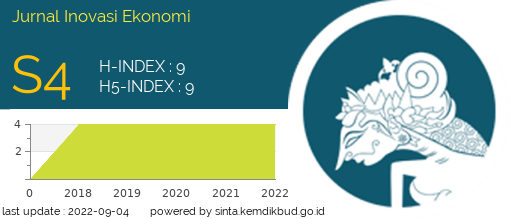E-wallet Adoption: Technology Acceptance Model and COVID-19
DOI:
https://doi.org/10.22219/jiko.v7i01.20385Keywords:
Behavioral intention, perceived ease of use, perceived usefulness, technology acceptance model, COVID-19Abstract
The development of information technology has almost entered all economic and daily activities, such as in the financial aspect (financial technology). Since the pandemic, many e-wallets have been used as digital payment tools in Batam city, especially ShopeePay. Therefore, this study aims to analyze the level of adoption of ShopeePay by utilizing the TAM component and perceived risk, which refers to disease risk known as perceived COVID-19 risk. Purposive sampling is used as a sampling technique, with 179 samples obtained through google Forms filed by respondents. The results of this study found that there is a significant influence between perceived usefulness and ease of use on behavioral intention. Meanwhile, perceived COVID-19 risk does not significantly affect behavioral intention.
Downloads
References
Aji, H. M., Berakon, I., & Md Husin, M. (2020). COVID-19 and e-wallet usage intention: a multigroup analysis between Indonesia and Malaysia. Cogent Business and Management, 7(1), 1–16. https://doi.org/10.1080/23311975.2020.1804181
Amanda, G. (2021, March 2). Pengguna dompet digital meningkat drastis di masa pandemi. Republika. https://www.republika.co.id/berita/qpc9e6423/pengguna-dompet-digital-meningkat-drastis-di-masa-pandemi
Batunanggar, S. (2019). Fintech Development and Asian Development Bank Institute. In ADBI Working Paper Series FINTECH (Issue 1014).
Budu, K. W. A., Yinping, M., & Mireku, K. K. (2018). Investigating the effect of behavioral intention on e-learning systems usage: empirical study on tertiary education institutions in Ghana. Mediterranean Journal of Social Sciences, 9(3), 201–216. https://doi.org/10.2478/mjss-2018-0062
Cooper, D. R., & Schindler, P. S. (2014). Business research methods (12th ed.). McGraw-Hill/Irwin.
Daragmeh, A., Lentner, C., & Sági, J. (2021). FinTech payments in the era of COVID-19: factors influencing behavioral intentions of “Generation X” in Hungary to use mobile payment. Journal of Behavioral and Experimental Finance, 32. https://doi.org/10.1016/j.jbef.2021.100574
Dong, C. (2020, July 11). Here’s How the pandemic is completely changing how we pay. The Points Guy. https://thepointsguy.com/guide/contactless-payment-guide/
Fernandes, N. (2020). Economic effects of coronavirus outbreak (COVID-19) on the world economy. IESE Business School Working Paper No. WP-1240-E, 0–29. https://doi.org/http://dx.doi.org/10.2139/ssrn.3557504
Giovanis, A., Assimakopoulos, C., & Sarmaniotis, C. (2018). Adoption of mobile self-service retail banking technologies: the role of technology, social, channel and personal factors. International Journal of Retail and Distribution Management, 47(9), 894–914. https://doi.org/10.1108/IJRDM-05-2018-0089
Hair, J. F., Hult, G. T., Ringle, C., & Sarstedt, M. (2017). A primer on partial least squares structural equation modeling (PLS-SEM). In Sage (2nd ed.). Sage Publications.
Mohd Amir, R. I., Mohd, I. H., Saad, S., Abu Seman, S. A., & Tuan Besar, T. B. H. (2019). Perceived ease of use, perceived usefulness, and behavioral intention: the acceptance of crowdsourcing platform by using Technology Acceptance Model (TAM). International Conference on the Future of ASEAN. https://doi.org/10.1007/978-981-15-3859-9_34
Muslichah. (2018). The effect of self efficacy and information quality on behavioral intention with perceived usefulness as intervening variable. JABM JOURNAL of ACCOUNTING - BUSINESS & MANAGEMENT, 1(25), 21–34. https://doi.org/10.31966/jabminternational.v1i25.327
Rehman, Z. U., & Shaikh, F. A. (2020). Critical factors influencing the behavioral intention of consumers towards mobile banking in Malaysia. Engineering, Technology & Applied Science Research, 10(1), 5265–5269. https://doi.org/10.48084/etasr.3320
Santoso, B. (2022, February 2). Kasus COVID-19 meningkat Pemkot Batam kembali ketatkan pengawasan PPKM - ANTARA News. Antaranews.Com. https://www.antaranews.com/berita/2679645/kasus-covid-19-meningkat-pemkot-batam-kembali-ketatkan-pengawasan-ppkm
Setiawan, B., Nugraha, D. P., Irawan, A., Nathan, R. J., & Zoltan, Z. (2021). User innovativeness and fintech adoption in Indonesia. Journal of Open Innovation: Technology, Market, and Complexity, 7(3), 1–18. https://doi.org/10.3390/joitmc7030188
Shaw, B., & Kesharwani, A. (2019). Moderating effect of smartphone addiction on mobile wallet payment adoption. Journal of Internet Commerce, 18(3), 291–309. https://doi.org/10.1080/15332861.2019.1620045
To, A. T., & Trinh, T. H. M. (2021). Understanding behavioral intention to use mobile wallets in Vietnam: extending the tam model with trust and enjoyment. Cogent Business and Management, 8(1). https://doi.org/10.1080/23311975.2021.1891661
Undale, S., Kulkarni, A., & Patil, H. (2021). Perceived e-wallet security: impact of COVID-19 pandemic. Vilakshan - XIMB Journal of Management, 18(1), 89–104. https://doi.org/10.1108/xjm-07-2020-0022
Winata, L. F. A., & Permana, D. (2020). The effect of electronic coupon value to perceived usefulness and perceived ease of use and its implication to behavioral intention to use server-based electronic money. International Journal of Innovative Science and Research Technology, 5(1), 147–158.
Yan, C., Siddik, A. B., Akter, N., & Dong, Q. (2021). Factors influencing the adoption intention of using mobile financial service during the COVID-19 pandemic: the role of FinTech. Environmental Science and Pollution Research. https://doi.org/10.1007/s11356-021-17437-y
Downloads
Published
Issue
Section
License
Copyright (c) 2022 Candy Candy, Shellyna Shellyna, Justyanita Justyanita, Kristiani Kristiani

This work is licensed under a Creative Commons Attribution-ShareAlike 4.0 International License.









